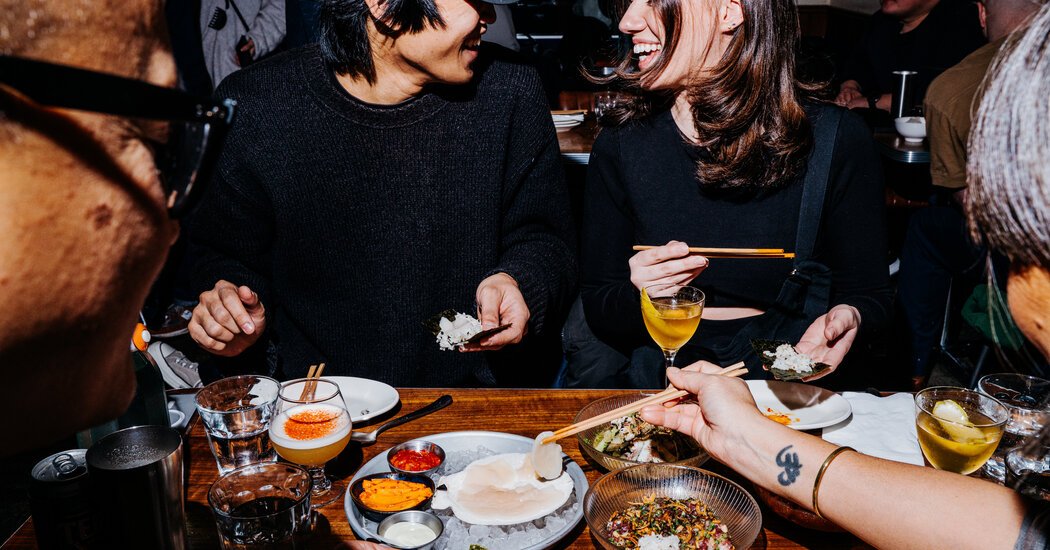Even on a chilly Monday evening, the wait at Cho Dang Gol was more than an hour.
Crowds of 20-somethings spilled out of the homey restaurant in Manhattan’s Koreatown, where steam billowed from stone bowls of soondubu jigae in a dining room ornamented with paper lanterns and musical instruments. Some hopeful customers peeked inside, anxious to see if a table had opened up.
A few blocks away, diners at Hojokban — a sleeker, more modern restaurant that opened last fall — eagerly snapped photographs of a plate of fried-rice wearing an empty Shin Ramyun noodle cup like a hat. The dish had already gone viral on TikTok.
A little to the south, Atomix, a Korean fine-dining restaurant with two Michelin stars, was booked solid through the next month. And the sought-after corn cake at nearby Lysée, a Korean-French pastry shop? It had been sold out since lunchtime.

Korean dining in New York has never been more interesting, dynamic or diverse. And a single company, which owns or co-owns all four of these restaurants and 17 more, is generating much of that innovation: Hand Hospitality.
Hand has achieved what many non-Western restaurants still find difficult to do in America: win wide appeal while focusing on a narrow audience — in this case, young Koreans and Korean Americans keen for a taste of the energy pouring out of South Korea.
“Rather than playing to an Americanized idea of what people would want from Korean food, they are just doing a version of what Koreans are eating in Seoul,” said E. Alex Jung, a staff writer for New York magazine who wrote its dining newsletter last year.
Some of Hand’s servers speak little English. Some dishes are identified on menus only in Korean. “They are not trying to appeal to non-Koreans,” Mr. Jung said.
Yet non-Koreans show up anyway. The company’s wide array of establishments reflects the ever-evolving, globalized shape of food in South Korea, a country whose vast cultural influence has become such a phenomenon that it has a name: hallyu.
Some Hand restaurants have been imported directly from Seoul and specialize in a single dish, like the bulgogi served at Samwoojung, or the soul-warming soup gomtang at Okdongsik. Other restaurants, like Atomix and Atoboy, are partnerships with Korean American chefs, or are influenced by French technique, like Lysée or Little Mad. A few are more casual and clubby, like Take31. (Hand even runs three Japanese restaurants: Izakaya Mew, Nonono and Hakata TonTon.)
“There is no limit to what Korean food can be,” Mr. Jung said, “and that is what they are demonstrating.”
But just who are the “they” at the head of Hand? Finding out took a little persistence and persuasion.
While many of the group’s chef partners are acclaimed names in food — including Junghyun and Ellia Park, who co-own Atomix and Atoboy, or Eunji Lee of Lysée — its lead players, Kihyun Lee and Kyungrim Kim, prefer to stay out of the spotlight. Their names aren’t listed on the Hand website. They declined interviews for this article several times. Ms. Kim, 32, asked if she could skip her photo shoot.
“We didn’t want to show off,” said Mr. Lee, 43, known as Kiro and identified on the website only as “the founder.” A soft-spoken man who favors baggy sweaters, he said one reason he agreed to talk was the chance to show the article to his mother, who lives in Incheon, South Korea, and his two young children — to make them proud.
Among his peers, Mr. Lee and his company are already considered trailblazers.
“They are an inspiration and an influence to Korean chefs in Korea and New York City chefs and just American chefs,” said Deuki Hong, 34, a chef and the author of the coming cookbook “Koreaworld,” who used to run the Koreatown barbecue restaurant Baekjeong.
“They are bending New York to their tastes,” he said.
Atoboy and Atomix, for example, have landed repeatedly on critics’ best-restaurant lists. (Atomix was No. 2 last year on The New York Times’s “100 Best Restaurants in New York City.”) But Ms. Park, who runs the two places, said she and her husband struggled to find investors in their contemporary vision for Korean food until they met Mr. Lee. He partnered with them and invested in their restaurants. (The Parks declined to specify the amount.)
Hand Hospitality’s success has been bolstered by its locale. New York has roughly 1.2 million people of Asian descent, and a dining public well-acquainted with myriad cuisines. The juggernaut of Korean culture today certainly helps.
And the company’s influence extends beyond its own restaurants, to places like the Korean-Southern restaurant C as in Charlie in downtown Manhattan. David JoonWoo Yun, who co-founded the restaurant last year, said Mr. Lee encouraged him to tap both his Korean heritage and his Atlanta roots, and serve sweet tea alongside mushroom bibimbap.
Because of Hand’s example, said Mr. Yun, 33, “more Koreans are trying to develop the cuisine into something more unique with their own background.”
Mr. Lee said that approach felt risky when he started out in 2011. He had grown up in a restaurant-owning family near a U.S. Air Force base in Pyeongtaek, South Korea, and moved to New York to attend the Fashion Institute of Technology. He and his friends couldn’t find places to hang out.
“There were no hip restaurants,” he recalled. “Everywhere was old, traditional food in K-Town.”
With a small-business loan of $300,000, Mr. Lee opened Take31 just off Koreatown’s main stretch. The soju selection ran deep, the servers were other young Koreans and the menu toggled between Korean and Japanese dishes, as Mr. Lee had lived in Japan for several years. He hosted exhibits for his artist friends and drew a small but loyal following.
People encouraged him to make the food sweeter to attract more customers. “But I don’t think like that,” he said. “I think we must show what is our core taste.”
He studied the restaurant business by reading the restaurateur Danny Meyer’s best-selling book “Setting the Table: The Transforming Power of Hospitality in Business.” It confused him. Why did anyone need to be taught how to be hospitable?
“For Asian people, hospitality is obvious, it is innate,” he said. “It is not something you learn or develop.”
Two years later, Mr. Lee opened Izakaya Mew, followed by Her Name Is Han, which serves traditional Korean food. He brought on partners — Keisuke Oku, Alex Bosung Park and Jinan Choi — to develop different parts of the business. Ms. Kim joined Hand in 2016 as a server at Her Name Is Han and became the company’s chief executive in 2022.
She said that until recently, when an outside investor put up some money, the business was supported primarily by Mr. Lee’s initial loan and subsequent profits, which it has rolled into new restaurants.
The opening of Her Name Is Han was a turning point, Mr. Lee said. Until then, most all Hand’s customers had been Korean. At Her Name Is Han, those people started bringing non-Koreans, who became repeat visitors.
Hand’s approach has remained more or less the same since then. “Usually the foods that we open restaurants around are from our childhood,” Ms. Kim said. “Most of our employees are immigrants from Korea or even from Japan. We are very Asian-focused.”
Mr. Lee visits South Korea regularly to find restaurants that will transplant well to New York. Hand often brings over not just the food, but also the minimalist and sometimes brutalist or industrial design sensibilities of certain Seoul restaurants. (The company works with the Korean American designer Junho Choi.)
Mr. Lee’s instincts are often spot-on. Okdongsik, a narrow soup counter specializing in gomtang, regularly draws long lines at lunchtime. Its success has led to locations in Tokyo and Honolulu that will open this year.
If a place doesn’t find an audience, the company may just turn it into another restaurant; after the small plates restaurant Palpal closed in 2023 after only a year, it was reborn as Hojokban. Menus constantly change to draw people back.
“They actually keep up with modern times,” said Hung Nguyen, 26, a venture capitalist who was eating on a recent evening at Take31, where the menu features many of the latest food trends from Korea, like dalgona, a honeycomb-esque candy, and mala seasoning. “When ‘Parasite’ came out, they introduced jjapaguri.”
Those innovations aren’t to everyone’s taste.
“I get the feeling that if I brought my Korean elders here, they would be like, ‘What have they done to the food?’” said Wook Bae, 31, a legal aide who was having dinner at Seoul Salon. The restaurant is Hand’s high-end version of a sool jib, or drinking establishment, with dishes like spicy octopus risotto and rose tteokbokki, cheese-topped rice cakes in a creamy, gochujang-spiked sauce.
By prioritizing a young clientele, Hand may also be alienating its older staffers and diners, who were frequenting Koreatown long before BTS became a household name. At Cho Dang Gol, a server in her 50s who started before Hand bought the restaurant in 2016, said that some dishes had been sweetened to appeal to young diners, and that she feared for her job.
“They are switching over to younger employees,” she said in Korean. (She did not give her name, saying she feared it would speed up her exit.) “There is nowhere I can go. I can’t speak English.”
Aiden Min, 39, the restaurant’s general manager, said that Hand had not altered recipes, and that there were no plans to let older servers go. They are part of the restaurant’s charm, he said, reminding diners of their mothers and aunts.
Yet it’s hard not to notice that people in their 20s or 30s are the ones flooding Koreatown on a nightly basis, whether for dinner, karaoke or a trip to H Mart.
Mr. Lee has planted Hand’s headquarters as well as most of its restaurants in Koreatown. This includes Joo Ok, which Hand will open in April as a play to make the neighborhood more of a destination for fine dining.
“Whoever built K-Town is amazing,” he said. “It is in the heart of Manhattan, right by the Empire State Building.”
To him, Koreatown represents the trajectory of Korean food and culture — a once-siloed space that, these days, can feel like the center of the universe.
Hannah Ahn contributed Korean-language translation for this article.










